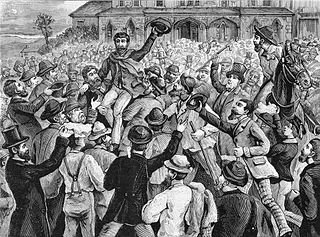
United States appellate procedure involves the rules and regulations for filing appeals in state courts and federal courts. The nature of an appeal can vary greatly depending on the type of case and the rules of the court in the jurisdiction where the case was prosecuted. There are many types of standard of review for appeals, such as de novo and abuse of discretion. However, most appeals begin when a party files a petition for review to a higher court for the purpose of overturning the lower court's decision.

An appellate court, commonly called a court of appeals, appeal court, court of appeal, court of second instance or second instance court, is any court of law that is empowered to hear an appeal of a trial court or other lower tribunal. In most jurisdictions, the court system is divided into at least three levels: the trial court, which initially hears cases and reviews evidence and testimony to determine the facts of the case; at least one intermediate appellate court; and a supreme court which primarily reviews the decisions of the intermediate courts, often on a discretionary basis. A jurisdiction's supreme court is that jurisdiction's highest appellate court. Appellate courts nationwide can operate under varying rules.
In the United States, a state supreme court is the highest court in the state judiciary of a U.S. state. On matters of state law, the judgment of a state supreme court is considered final and binding in both state and federal courts.

The terms moot and mootness are used in both in English and American law, although with different meanings.

The United States courts of appeals or circuit courts are the intermediate appellate courts of the United States federal judiciary. The courts are divided into 13 circuits, and each hears appeals from the district courts within its borders, or in some instances from other designated federal courts and administrative agencies. Appeals from the circuit courts are taken to the Supreme Court of the United States. The district, appellate, and Supreme courts are all authorized under Article Three of the United States Constitution.

In common law jurisdictions, an acquittal certifies that the accused is free from the charge of an offense, as far as the criminal law is concerned. The finality of an acquittal is dependent on the jurisdiction. In some countries, such as the United States, an acquittal operates to bar the retrial of the accused for the same offense, even if new evidence surfaces that further implicates the accused. The effect of an acquittal on criminal proceedings is the same whether it results from a jury verdict or results from the operation of some other rule that discharges the accused. In other countries, the prosecuting authority may appeal an acquittal similar to how a defendant may appeal a conviction.

Appellate jurisdiction is the power of an appellate court to review, amend and overrule decisions of a trial court or other lower tribunal. Most appellate jurisdiction is legislatively created, and may consist of appeals by leave of the appellate court or by right. Depending on the type of case and the decision below, appellate review primarily consists of: an entirely new hearing ; a hearing where the appellate court gives deference to factual findings of the lower court; or review of particular legal rulings made by the lower court.
United States v. Dominguez Benitez, 542 U.S. 74 (2004), was a United States Supreme Court case in which the Court ruled that, in a criminal proceeding in federal court, a defendant who does not alert the district court to a possible violation of Rule 11 of the Federal Rules of Criminal Procedure must show on appeal that the violation affirmatively affected his rights in order to obtain reversal of his conviction by guilty plea. Rule 11, which pertains to criminal prosecutions in United States federal courts only, governs the offering of plea bargains to criminal defendants and the procedures district courts must employ to ensure that the defendant knows of and properly waives his trial-related constitutional rights.
The writ of coram nobis is a legal order allowing a court to correct its original judgment upon discovery of a fundamental error that did not appear in the records of the original judgment's proceedings and would have prevented the judgment from being pronounced. The term "coram nobis" is Latin for "before us" and the meaning of its full form, quae coram nobis resident, is "which [things] remain in our presence". The writ of coram nobis originated in the courts of common law in the English legal system during the sixteenth century.
United States v. Booker, 543 U.S. 220 (2005), is a United States Supreme Court decision on criminal sentencing. The Court ruled that the Sixth Amendment right to jury trial requires that other than a prior conviction, only facts admitted by a defendant or proved beyond a reasonable doubt to a jury may be used to calculate a sentence exceeding the prescribed statutory maximum sentence, whether the defendant has pleaded guilty or been convicted at trial. The maximum sentence that a judge may impose is based upon the facts admitted by the defendant or proved to a jury beyond a reasonable doubt.
In law, the standard of review is the amount of deference given by one court in reviewing a decision of a lower court or tribunal. A low standard of review means that the decision under review will be varied or overturned if the reviewing court considers there is any error at all in the lower court's decision. A high standard of review means that deference is accorded to the decision under review, so that it will not be disturbed just because the reviewing court might have decided the matter differently; it will be varied only if the higher court considers the decision to have obvious error. The standard of review may be set by statute or precedent. In the United States, "standard of review" also has a separate meaning concerning the level of deference the judiciary gives to Congress when ruling on the constitutionality of legislation.
Greenlaw v. United States, 554 U.S. 237 (2008), was a United States Supreme Court case in which the Court held that a federal appeals court may not sua sponte increase a defendant's sentence unless the government first files a notice of appeal.
Forfeiture and waiver are two concepts that U.S. courts apply in determining whether reversible error has occurred. Waiver is the voluntary relinquishment, surrender or abandonment of some known right or privilege. Forfeiture is the act of losing or surrendering something as a penalty for a mistake or fault or failure to perform, etc.
United States v. More, 7 U.S. 159 (1805), was a United States Supreme Court case in which the Court held that it had no jurisdiction to hear appeals from criminal cases in the circuit courts by writs of error. Relying on the Exceptions Clause, More held that Congress's enumerated grants of appellate jurisdiction to the Court operated as an exercise of Congress's power to eliminate all other forms of appellate jurisdiction.

In law, an appeal is the process in which cases are reviewed by a higher authority, where parties request a formal change to an official decision. Appeals function both as a process for error correction as well as a process of clarifying and interpreting law. Although appellate courts have existed for thousands of years, common law countries did not incorporate an affirmative right to appeal into their jurisprudence until the 19th century.
United States v. Vampire Nation, 451 F.3d 189, is a 2006 decision of the United States Court of Appeals for the Third Circuit regarding the Federal Sentencing Guidelines and asset forfeiture. A three-judge panel unanimously affirmed the conviction and sentence of Frederick Banks, a Pittsburgh man, on numerous felony charges resulting from fraudulent schemes carried out over the Internet. The case takes its title, which has been singled out as memorable and included among lists of amusingly titled cases, from one of Banks' aliases, an electronic music group of which he was the sole regular member. He had filed the appeal under that name while representing himself.
Molina-Martinez v. United States, 578 U.S. ___ (2016), was a United States Supreme Court case in which the Court held that the United States Court of Appeals for the Fifth Circuit's reliance on a requirement that defendants show "additional evidence" to show substantial harm arising from incorrect sentencing guidelines is impermissible.
Fundamental error is a legal term provided by United States Courts to describe an error which occurs whenever a judgement violates a federal fundamental right. In United States constitutional law, fundamental rights have special significance under the U.S. Constitution. Those rights enumerated in the U.S. Constitution are recognized as "fundamental" by the U.S. Supreme Court. State courts within the United States may define fundamental error rules independently of the federal courts. State fundamental error rules may include errors which violate rights in additional to those rights guaranteed by the U.S. Constitution, but these rules may not infringe upon federal fundamental rights. Any law restricting such a right must both serve a compelling state purpose and be narrowly tailored to that compelling purpose.
United States v. Morgan, 346 U.S. 502 (1954), is a landmark decision by the United States Supreme Court which provides the writ of coram nobis as the proper application to request federal post-conviction judicial review for those who have completed the conviction's incarceration in order to challenge the validity of a federal criminal conviction.
Burks v. United States, 437 U.S. 1 (1978), is a United States Supreme Court decision that clarified both the scope of the protection against double jeopardy provided by the Fifth Amendment to the United States Constitution and the limits of an appellate court's discretion to fashion a remedy under section 2106 of Title 28 to the United States Code. It established the constitutional rule that where an appellate court reverses a criminal conviction on the ground that the prosecution failed to present sufficient evidence to prove the defendant's guilt beyond a reasonable doubt, the Double Jeopardy Clause shields the defendant from a second prosecution for the same offense. Notwithstanding the power that appellate courts have under section 2106 to "remand the cause and direct the entry of such appropriate judgment, decree, or order, or require such further proceedings to be had as may be just under the circumstances," a court that reverses a conviction for insufficiency of the evidence may not allow the lower court a choice on remand between acquitting the defendant and ordering a new trial. The "only 'just' remedy" in this situation, the Court held, is to order an acquittal.







